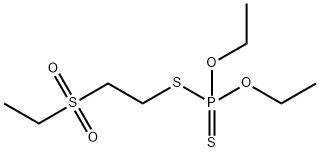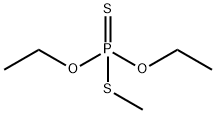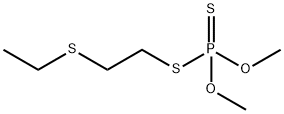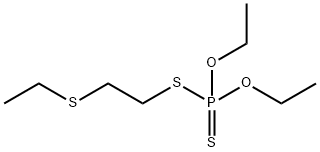DISULFOTON-SULFOXIDE
- CAS NO.:2497-07-6
- Empirical Formula: C8H19O3PS3
- Molecular Weight: 290.4
- MDL number: MFCD00155402
- EINECS: 219-679-1
- SAFETY DATA SHEET (SDS)
- Update Date: 2024-03-14 15:18:26

What is DISULFOTON-SULFOXIDE?
Description
Oxydisulfoton is a liquid. Molecularweight = 290.42. Hazard Identification (based on NFPA-704 M Rating System): Health 4, Flammability 1,Reactivity 0.
Chemical properties
Oxydisulfoton is a combustible liquid.
The Uses of DISULFOTON-SULFOXIDE
Disulfoton Sulfoxide is a disulfoton (D493695)'s degradate. Disulfoton, an organophosphate acetylcholinesterase inhibitor, is most commonly used for its pesticidal & insecticidal properties in the agricultural industry.
Definition
ChEBI: Oxydisulfoton is an organic thiophosphate.
General Description
Liquid. Used as an agricultural insecticide.
Reactivity Profile
Organophosphates, such as DISULFOTON-SULFOXIDE, are susceptible to formation of highly toxic and flammable phosphine gas in the presence of strong reducing agents such as hydrides. Partial oxidation by oxidizing agents may result in the release of toxic phosphorus oxides. On heating, oxydisulphoton gets decomposed and releases toxic gases and vapours (SOx, POx).
Health Hazard
DISULFOTON-SULFOXIDE is highly toxic orally and through the skin. DISULFOTON-SULFOXIDE is an organophosphate pesticide.
Fire Hazard
(Non-Specific -- Organophosphorus Pesticide, n.o.s.) Some materials may burn but none of them ignite easily. Container may explode in the heat of fire. When heated to decomposition, DISULFOTON-SULFOXIDE emits very toxic fumes of oxides of sulfur and phosphorus.
Safety Profile
Poison by ingestion and skin contact. When heated to decomposition it emits very toxic fumes of SOx and POx.
Potential Exposure
This material is an agricultural insecticide.
First aid
If this chemical gets into the eyes, remove anycontact lenses at once and irrigate immediately for at least15 min, occasionally lifting upper and lower lids. Seek medical attention immediately. If this chemical contacts theskin, remove contaminated clothing and wash immediatelywith soap and water. Speed in removing material from skinis of extreme importance. Shampoo hair promptly if contaminated. Seek medical attention immediately. If thischemical has been inhaled, remove from exposure, beginrescue breathing (using universal precautions, includingresuscitation mask) if breathing has stopped and CPR ifheart action has stopped. Transfer promptly to a medicalfacility. When this chemical has been swallowed, get medical attention. Give large quantities of water and inducevomiting. Do not make an unconscious person vomit. Keepvictim quiet and maintain normal body temperature. Effectsmay be delayed; keep victim under observation.
storage
Color Code—Blue: Health Hazard/Poison: Storein a secure poison location. Prior to working with thischemical you should be trained on its proper handling andstorage.
Shipping
UN3018 Organophosphorus pesticides, liquid, toxic, Hazard Class: 6.1; Labels: 6.1-Poisonous materials.
Incompatibilities
Vapor may form explosive mixture with air. Incompatible with oxidizers (chlorates, nitrates, peroxides, permanganates, perchlorates, chlorine, bromine, fluorine, etc.); contact may cause fires or explosions. Keep away from alkaline materials, strong bases, strong acids, oxoacids, and epoxides. Strong oxidizers may cause release of toxic phosphorus oxides. Organophosphates, in the presence of strong reducing agents such as hydrides, may form highly toxic and flammable phosphine gas. Keep away from alkaline materials.
Waste Disposal
In accordance with 40CFR 165 recommendations for the disposal of pesticides and pesticide containers. Must be disposed properly by following package label directions or by contacting your local or federal environmental control agency, or by contacting your regional EPA office.
Properties of DISULFOTON-SULFOXIDE
| Boiling point: | 156.5°C |
| Density | 1.2156 g/cm3 |
| storage temp. | 2-8°C |
| form | Liquid |
| EPA Substance Registry System | Oxydisulfoton (2497-07-6) |
Safety information for DISULFOTON-SULFOXIDE
Computed Descriptors for DISULFOTON-SULFOXIDE
New Products
4-AMINO-TETRAHYDRO-PYRAN-4-CARBOXYLIC ACID HCL 4-(Dimethylamino)tetrahydro-2H-pyran-4-carbonitrile 4-Aminotetrahydropyran-4-carbonitrile Hydrochloride (R)-3-Aminobutanenitrile Hydrochloride 3-((Dimethylamino)methyl)-5-methylhexan-2-one oxalate 1,4-Dioxa-8-azaspiro[4.5]decane 5-Bromo-2-nitropyridine Nimesulide BP Aceclofenac IP/BP/EP Diclofenac Sodium IP/BP/EP/USP Mefenamic Acid IP/BP/EP/USP Ornidazole IP Diclofenac Potassium THOMAIND PAPER PH 2.0 TO 4.5 1 BOX BUFFER CAPSULE PH 9.2 - 10 CAP SODIUM CHLORIDE 0.1N CVS ALLOXAN MONOHYDRATE 98% PLATINUM 0.5% ON 3 MM ALUMINA PELLETS (TYPE 73) LITHIUM AAS SOLUTION 2-Bromo-1-(bromomethyl)-3-chloro-5-nitrobenzene 2-Bromo-3-nitroaniline N-(3-Hydroxypropyl)-N-methylacetamide 3-Bromo-6-chloropyridazine 4-ethyl-3-nitrobenzoic acidRelated products of tetrahydrofuran







You may like
-
 Disulfoton-sulfoxide CAS 2497-07-6View Details
Disulfoton-sulfoxide CAS 2497-07-6View Details
2497-07-6 -
 1-Methyl-6-oxo-1,6-dihydropyridazine-3-carbonitrile 98%View Details
1-Methyl-6-oxo-1,6-dihydropyridazine-3-carbonitrile 98%View Details
99903-60-3 -
 1823368-42-8 98%View Details
1823368-42-8 98%View Details
1823368-42-8 -
 2-(3-(tert-butyl)phenoxy)-2-methylpropanoic acid 1307449-08-6 98%View Details
2-(3-(tert-butyl)phenoxy)-2-methylpropanoic acid 1307449-08-6 98%View Details
1307449-08-6 -
 Ethyl 3-(furan-2-yl)-3-hydroxypropanoate 25408-95-1 98%View Details
Ethyl 3-(furan-2-yl)-3-hydroxypropanoate 25408-95-1 98%View Details
25408-95-1 -
 2-Chloro-5-fluoro-1-methoxy-3-methylbenzene 98%View Details
2-Chloro-5-fluoro-1-methoxy-3-methylbenzene 98%View Details
1805639-70-6 -
 1784294-80-9 98%View Details
1784294-80-9 98%View Details
1784294-80-9 -
 Lithium ClavulanateView Details
Lithium ClavulanateView Details
61177-44-4